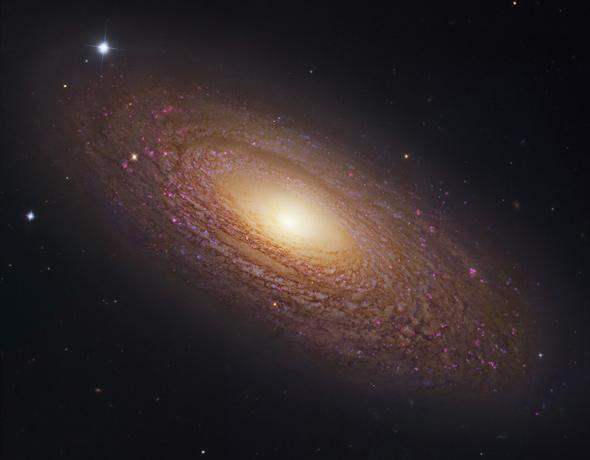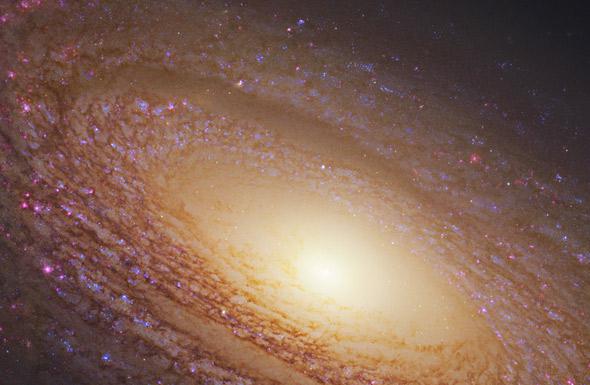Forty-five million light years away, toward the constellation of Ursa Major, sits a rather unremarkable galaxy. It is not undergoing huge bursts of star formation. It is not blasting out radiation from its core. It isn’t twisted into bizarre shapes by the gravitational influence of a nearby passing galaxy, nor actively eating any smaller galaxies, nor swaddled in thick layers of dust.
It just is, sitting there, being a spiral galaxy. And that’s what makes it so stunningly gorgeous.

Photo by Robert Gendler, NASA/ESA, Subaru, and DSS, used by permission
That image was created by noted astrophotographer Robert Gendler, who made it using observations by Hubble, the 8.2 meter Subaru telescope, the Digitized Sky Survey, and some of his own images. It is breathtaking in its beauty, showing a galaxy remarkable in its unremarkableness.
I wrote details about NGC 2841 in an earlier article, when the Hubble image was released. Try as I might, I found very little about this galaxy to make it stand out. It’s an absolutely normal spiral galaxy. The only even mildly unusual things about it are that it has some activity in its core that has very slightly warmed up the gas there (probably due to weak action around its central super-massive black hole) and that it’s quite large. NGC 2841 is probably about 100,000 light years across, the same size as our home, the Milky Way galaxy. It almost certainly got that size by merging with other galaxies over the eons, growing each time, but that gluttony has long since passed; NGC 2841 is now stable, quiet, and excruciatingly lovely.
There is one thing I want to point out. The arms of the galaxy are numerous and short, studded with pink gas clouds where stars are being born and larger clouds of opaque dust that block the light from stars behind them. That gives the galaxy a categorization of “flocculent,” a word I quite like.

Photo by Robert Gendler, NASA/ESA, Subaru, and DSS
But it also leads to an interesting effect. In the close-up above, you can see that the dust on the near side of the galaxy (left and below the center) is more obvious and seems to fade out on the far side of the galaxy. This is due to geometry, plus the thickness of the galaxy itself.
On the near side, we have a clear view of the flat spiral disk of the galaxy. Both the stars and the dust and easily visible, the contrast high. But when we look to the far side we are looking across the galaxy itself. There are stars above the plane of the disk, and especially in the roughly spherical core of the galaxy as well. The individual billions of stars blur together to form a glow, a fuzz, and that “fills in” the dark patches of the dust on the far side of the galaxy. Just as the dust itself blocks light from stars behind it, the stars in front of the dust glow too, and make the puffy dust clouds harder to see. It’s a quick and easy trick to figure out which way the galaxy is tipped, which might be hard to determine by eye otherwise.
I have looked at and admired images of literally thousands of galaxies, and over the years I have discovered that there is no such thing as a boring one. Even the most mundane is a vast, sprawling collection of billions of stars, huge clouds of gas and dust, and structure on a scale so grand it dwarfs all of human achievements to a microscopic dot.
Nothing in nature is boring. It is a story told on the tapestry of the Universe, it is all interwoven, and the best part is that we are a part of it, and can try to understand it for ourselves.